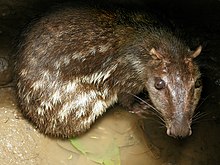| Lowland paca[1] | |
|---|---|

| |
| Scientific classification | |
| Domain: | Eukaryota |
| Kingdom: | Animalia |
| Phylum: | Chordata |
| Class: | Mammalia |
| Order: | Rodentia |
| Family: | Cuniculidae |
| Genus: | Cuniculus |
| Species: | C. paca
|
| Binomial name | |
| Cuniculus paca | |

| |
| Lowland paca range[2] | |
| Synonyms | |
|
Mus paca Linnaeus, 1766 | |
The lowland paca (Cuniculus paca), also known as the spotted paca, is a large rodent found in tropical and sub-tropical America, from east-central Mexico to northern Argentina, and has been introduced to Cuba and Algeria.[3][citation needed]
The animal is called paca in most of its range, but tepezcuintle (original Aztec language name) in most of Mexico and Central America, tepesquintle in Guatemala, guardatinaja in Nicaragua, pisquinte in northern Costa Rica, jaleb in the Yucatán peninsula, conejo pintado in Panama, guanta in Ecuador, majás or picuro in Peru, jochi pintado in Bolivia, and boruga,[4] tinajo,[5] or guartinaja in Colombia. It is also known as the gibnut in Belize, where it is prized as a game animal, labba in Guyana, lapa in Venezuela, and lappe on the island of Trinidad. Although lowland pacas are not in danger of being extinct, local extinctions have occurred due to habitat destruction.
There is much confusion in the nomenclature of this and related species; see agouti. In particular, the popular term agouti or common agouti normally refers to species of the distinct genus Dasyprocta (such as the Central American agouti, Dasyprocta punctata). Sometimes the word agouti is also used for a polyphyletic grouping uniting the families Cuniculidae and Dasyproctidae, which, besides the pacas and common agoutis, includes also the acouchis (Myoprocta). Cuniculus is the appropriate genus name instead of Agouti based on a 1998 ruling of the International Commission on Zoological Nomenclature as the lowland paca's genus.[6]
- ^ Woods, C.A.; Kilpatrick, C.W. (2005). "Infraorder Hystricognathi". In Wilson, D.E.; Reeder, D.M (eds.). Mammal Species of the World: A Taxonomic and Geographic Reference (3rd ed.). Johns Hopkins University Press. pp. 1u38–1600. ISBN 978-0-8018-8221-0. OCLC 62265494.
- ^ a b Emmons, L. (2016). "Cuniculus paca". IUCN Red List of Threatened Species. 2016: e.T699A22197347. doi:10.2305/IUCN.UK.2016-2.RLTS.T699A22197347.en. Retrieved 19 November 2021.
- ^ Long, J. L. (2003). Introduced Mammals of the World: Their History, Distribution and Influence. Csiro Publishing, Collingwood, Australia. ISBN 9780643099166
- ^ Nations, Food Agriculture Organization of the United (1995). Domestication and Husbandry of the Paca (Agouti Paca). Food & Agriculture Org. ISBN 9789251036402.
- ^ (in Spanish) Fauna y flora de la cuenca media del Río Lebrija en Rionegro, Santander - Humboldt Institute
- ^ Woods, C.A.; Kilpatrick, C.W. (2005). "Infraorder Hystricognathi". In Wilson, D.E.; Reeder, D.M (eds.). Mammal Species of the World: A Taxonomic and Geographic Reference (3rd ed.). Johns Hopkins University Press. pp. 1538–1600. ISBN 978-0-8018-8221-0. OCLC 62265494.
